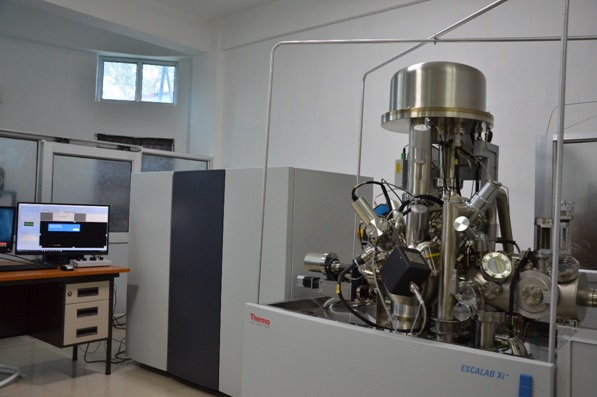





Sophisticated Analytical Instruments Facility
| Name of the equipment/facility: X-Ray Photoelectron Spectrometer (XPS) |  |
||||||||||||||||||||||||||||||||||||
| Make: Thermo Fisher Scientific Pvt. Ltd., UK | |||||||||||||||||||||||||||||||||||||
| Model: ESCALAB Xi+ | |||||||||||||||||||||||||||||||||||||
| Specification: | |||||||||||||||||||||||||||||||||||||
1. XPS - X-ray photoelectron Spectroscopy for investigation of the chemical state, elemental composition of materials such as inorganic, organic, polymeric, nanocomposites etc.
2. Twin anode Non-Monocromated XPS facility. Dual anode Mg K/Al K Micro focused monochromated Al K X-ray sources and dual anode Al/Mg K source
3. Double focusing full 180 degree hemispherical analyzer is provided. Magnetic and multielement electrostatic input lenses for spectroscopy.
4. Ultraviolet Photoelectron Spectroscopy facility is there.
5. Auger Electron Spectroscopy - 10 eV Auger Electron Source.
6. A UHV Mu-Metal chamber and sample preparation chamber for the XPS system. Standard Preploc chamber, which is a combined sample entry lock and preparation chamber. Mini view point with a computer controlled LED light sources. Preloc Chamber Vacuum 7x10-9mbar. Vacuum level in analysis chamber: ≤5x10-10 mbar
7. Flood gun- charge neutraliser system.
8. Source-defined area selection - The monochromated X-ray beam can be focused to spot sizes ranging from 900 µm to 200 µm. Lens-defined area selection - Computer-controlled irises in the transfer lens can be set to provide a lateral resolution down to 20 µm. Performed to scan with a larger area which cover 8 mm x 8mm Fully automated 5 axis (X,Y,Z, rotation and tilt)
9. Source for Depth profiling: Ion source (Argon ion) and Argon ion cluster
10. In situ heating and cooling stage (-100°C to 700°C) option and to maintain all 5 axes functionality.
11. Parallel imaging produces rapid, high resolution XPS chemical images less than 3 m chemical imaging resolution. Angle dependent XPS measurement can performed.
12. Advantage data system software package.
|
|||||||||||||||||||||||||||||||||||||
| Working Principle: | |||||||||||||||||||||||||||||||||||||
| Electron Spectroscopy for Chemical analysis (ESCA) instrument comprises of X-photoelectron spectroscopy (XPS), Ultra-violet photoelectron spectroscopy (UPS) and Auger spectroscopy (AES). X-ray photoelectron spectroscopy (XPS) is a surface characterization technique that can analyze a sample to a depth of 2 to 5 nm. Kai Siegbahn, who won the Nobel Prize in physics in 1981 for his research, developed XPS in the 1960s. XPS reveals which chemical elements are present at the surface and the nature of the chemical bond that exists between these elements. It can detect all of the elements except hydrogen and helium. A surface is irradiated with X-rays (commonly Al Kα or Mg Kα) in ultrahigh vacuum (UHV) conditions ≤5x10-10mbar. When an x-ray photon hits and transfers this energy to a core-level electron, it is emitted from its initial state with a kinetic energy dependent on the incident X-ray and binding energy of the atomic orbital from which it originated. The energy and intensity of the emitted photoelectrons are analysed to identify and determine the concentrations of the elements present. These photoelectrons originate from a depth of <10 nm therefore the information obtained is from within this depth. | |||||||||||||||||||||||||||||||||||||
| Applications: | |||||||||||||||||||||||||||||||||||||
| 1. The ESCALAB Xi+ will be used for the research and development purpose to investigate the elemental composition and electronic state of different type of nanocomposite materials, nanoparticles, metal oxide, clay particle, cement, catalyst, polymers etc.
2. Relative quantification of each chemical state of each element
3. Depth profiling of the materials.
4. Special distribution of material and chemical state |
|||||||||||||||||||||||||||||||||||||
| User Instructions: | |||||||||||||||||||||||||||||||||||||
| • External Users( Other than CSIR):
a) External sample users need to down load registration form and submit it to lab along with the requisite demand draft or online payment copy. The sample should be submitted personally on the day of allotted time slot. Analysis will be performed on the next day and results will be sent through email.
b) The sample should be completely dry and it should be stable in ultra-high vacuum
c) User should clearly mention if the sample needs etching (surface cleaning) before recording the data. It may be noted that the etching may alter the chemical composition and chemical state to some extent.
d) Be careful for the surface contamination of the sample surface. Try not to touch the surface of your sample with anything (fingers, gloves, breath etc.)
e) User should indicate the magnetic property of the samples.
f) Users are encouraged to be present during the analysis of their samples.
g) Getting back the sample: Users desiring to get back the sample need to mark on the form. Collect them from the Advanced Analytical Facility, Bhatnagar Building between 9:30 AM to 11:00 AM after completion of the work and uncollected samples will be disposed-off after one week of the intimation of the completion of the work and no reminder will be sent.
h) All samples should accompany material safety data sheets (MSDS).
• Internal Users:
a) User should submit the sample to the Advanced Analytical Facility, Bhatnagar Building along with the sample requisition form.
b) The sample should be completely dry and it should be stable in ultra-high vacuum
c) User should clearly mention if the sample needs etching (surface cleaning) before recording the data. It may be noted that the etching may alter the chemical composition and chemical state to some extent.
d) Keep the sample clean. Try not to touch the surface of your sample with anything (fingers, gloves, breath etc.)
e) User should indicate the magnetic property of the samples.
f) Users are encouraged to be present during the analysis of their samples.
|
|||||||||||||||||||||||||||||||||||||
| Contact | |||||||||||||||||||||||||||||||||||||
| 1. Dr Manash R. Das, Scientist
Email: mrdas@neist.res.in, mnshrdas@yahoo.com
Mobile: +91-9957178399
2. Dr Ajit Singh, Scientist Email: ajitsingh@@neist.res.in Mobile: +91-9527922665 |
|||||||||||||||||||||||||||||||||||||
| Charges (Excluding Taxes) | |||||||||||||||||||||||||||||||||||||
|
|||||||||||||||||||||||||||||||||||||